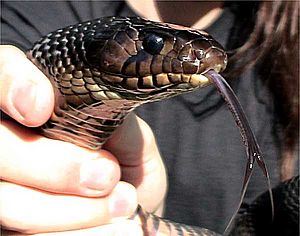Texas indigo snake facts for kids
Quick facts for kids Drymarchon melanurus erebennus |
|
|---|---|
 |
|
| Texas indigo snake | |
| Scientific classification |
|
| Kingdom: | Animalia |
| Phylum: | Chordata |
| Class: | Reptilia |
| Order: | Squamata |
| Suborder: | Serpentes |
| Family: | Colubridae |
| Genus: | Drymarchon |
| Species: | |
| Subspecies: |
D. m. erebennus
|
| Trinomial name | |
| Drymarchon melanurus erebennus (Cope, 1860)
|
|
| Synonyms | |
|
|
The Texas Indigo Snake (scientific name: Drymarchon melanurus erebennus) is a really big snake that doesn't have venom. It belongs to a group of snakes called Colubridae. You can find this snake naturally in Texas and nearby parts of Mexico.
Contents
Where the Texas Indigo Snake Lives
This snake lives in southern Texas and stretches south into Mexico, all the way to a place called Veracruz.
What the Texas Indigo Snake Looks Like
The Texas Indigo Snake is mostly black on its back. It has a shiny look that makes its smooth scales shimmer with different colors, like a rainbow! Its belly is often a pretty salmon pink color.
These snakes are quite large. They often grow longer than 6 ft (1.8 m) (about 1.8 meters) from head to tail. Some have even been seen as long as 8 ft (2.4 m) (about 2.4 meters)!
Home Sweet Home: Texas Indigo Snake Habitat
The Texas Indigo Snake likes places with a bit of plants, not too far from water. You can also find it in mesquite savannah areas, open grasslands, and sandy coastal dunes. When it needs a safe place to rest, it often uses burrows that other animals have left behind.
How the Texas Indigo Snake Behaves and What It Eats
The Texas Indigo Snake is diurnal, which means it is active during the day. It spends most of its time moving around and looking for food. This snake will eat almost anything it can catch and swallow! Its diet includes mammals, birds, lizards, frogs, turtles, eggs, and even other snakes. This includes dangerous rattlesnakes!
Because it helps control rattlesnakes, many farmers in southern Texas think of it as a helpful friend. There's even a saying: "If it's an indigo, let it go." This snake is usually not aggressive. However, if it feels threatened or is handled, it might bite. It can also release a bad-smelling musk from its body as a warning. Like many snakes in its family, it might shake its tail to scare off threats, even though it doesn't have a rattle.
Life Cycle and Reproduction
Texas Indigo Snakes usually breed once a year during the winter. The female snake lays a group of eggs, called a clutch, in the spring. A clutch usually has about 10 to 12 eggs. The eggs hatch after about 80 days. Baby snakes can be up to 26 in (66 cm) (about 66 cm) long when they hatch. These snakes become adults and can have their own babies when they are 2 to 3 years old.
Protecting the Texas Indigo Snake
The Texas Indigo Snake is listed as a threatened species in the state of Texas. This means it needs protection because its numbers are decreasing. The biggest problem for these snakes is losing their homes. As more people build houses and cities, the snake's natural habitat shrinks. Each snake needs a large area to find food, and urban sprawl (cities growing bigger) makes this harder. Roads also cut through their territory, and sadly, many snakes are hit by cars each year.

